The Cornell Lab Bird Academy › Discussion Groups › Nature Journaling and Field Sketching › Jump Right in!
-
Drawing from a photo is technally easier because nothing moves. Plenty of time to look, draw, erase, redraw.
-
I was surprised how focusing on the details changed what I saw. Shapes and striations I would have never noticed. Also little things like the toes of one foot were not wrapped around the branch. Also placement of the eye relative to the beak. So interesting to see what I miss by not paying attention to the destabilize.

-
Drawing from the photo makes us observe all the ways the feathers interact, their various colors and textures. You look at those skinny legs and how they grab the twig. You see all the different colors of lichens.
-
Pretty 👍
-
Drawing from the photo, I felt that I had time enough to capture the bird morphology, plumage, and body proportions. To sketch the whole body in proportion was easy with the photo as reference, trying to emphasize details like the number of primary and secondary wing feathers was challenging. Yes, I did not notice before that the ventral stripes of this yellow warbler were of a different color (brown) than the stripes on the rest of its body (black). It makes a difference depending on the goal of this particular entry, to document just the presence of the bird, or to make a study towards a correct illustration.
-
 It was hard to be confident that I could do this! Realize I need a good eraser,,, thought about shapes I saw like the other person said they did. Was happy with this try
It was hard to be confident that I could do this! Realize I need a good eraser,,, thought about shapes I saw like the other person said they did. Was happy with this try -
Since the picture was clear, it was easier to draw looking at it as reference. However, I was having a little trouble with sizing and shading, as you can see there is minimal shading in my drawing. The bird came quite easily, I was having trouble with the tree branches and leaves. And the claws of the bird. I may not have noticed the brown markings on the belly of the bird if i hadn't been asked to draw it. Yes I think it would be far harder to get these details when drawing outdoors. Also, to get size positioning, negative spaces shading etc.

-
It was fun creating some kind of likeness of the bird in the drawing. It is an impression rather than a reproduction. I didn't feel confident about the drawing or the painting, in fact it is one of my first times trying watercolours and I had trouble mixing the media and confidently applying it. I am not very happy with my colours. I also didn't feel confident about "owning" my journal page. At first it was an empty sheet and then I put the image on it .... and then, "what will I write and where???" Regarding looking at the photo and seeing things I may not have otherwise noticed, yes and no. I did see what was in the photo as I would have used the details for ID, however i certainly took more notice of the detail of what was there and that has re-inforced those features in my mind. These details might be useful as notes to make at the side of drawing as I will never be able to quickly capture such details in a watercolour - not as far as I can imagine anyway!

-
I'd be so happy to have an image as good as this by end of course - I particularly like how you captured the head well. I struggled with that shape and placement of eye and beak. question: did you start with a pencil outline? hard to see if you did.
-
-
1. Drawing from a photo is my usual method, I tend to trace details when i cant get them right, so this was a good exercise for my minds eye. I feel the perspective is a little off, i had a difficult time positioning the head and getting the body length correct. 2. The texture and variation in the leaves and branches, i tend to draw leaves at the same angles and taper branches more than necessary

-
Watercolor is unpredictable and difficult to correct. The colors didn't transfer faithfully to the jpeg. One challenge was to put the eye in the right spot on the side of the head. It was helpful to try to visualize the bones that underlie the masses. The more I looked, the more I saw and it took way to long to do this exercise. I anticipate the I'll have difficulty catching the moment when in a natural setting.

-
Drawing from an image allows more time to focus and add details; however, it also grants the viewer the time to dwell on aspects you may have overlooked in nature, which can be a blessing and a curse. For instance, a photo allows the opportunity and time to complete the drawing without disruption but also introduces the ability to erase and become critical of your journaling.

-
 I did okay for my first attempt. The eye is a bit too big. I could see the angles and the shapes, but it is more challenging to replicate. The shading and the coloring is challenging in just a pencil drawing. I noticed how the moss is similar in color to the warbler. Drawings can capture the minute details. Photographs can show clearly the intense colors.
I did okay for my first attempt. The eye is a bit too big. I could see the angles and the shapes, but it is more challenging to replicate. The shading and the coloring is challenging in just a pencil drawing. I noticed how the moss is similar in color to the warbler. Drawings can capture the minute details. Photographs can show clearly the intense colors. -
I prefer to draw from a drawing because it shows me how the artist interpreted the image and I am better at copying other drawings. I see that the eye is too big and that a yellow warbler is smaller and rounder than I depicted. My painting skills will hopefully improve over time... I used Sibley's to copy the notes on the page. I want to learn as much as I can about birds.

-
I’m used to drawing from photos, but I would prefer to draw in situ. Getting the perspective on the branch was difficult. I wouldn’t have noticed the subtleties of the coloring on the warbler, especially on his head & around his eye. I would think the more I notice the better my drawing/painting will be.

-
 I like the stability and clarity of the photo, though I'd rather be outside with this little guy. I noticed colors and feather shapes I would not have without drawing it. I'm definitely here to draw and not take photos-- though I'll keep doing that, too!
I like the stability and clarity of the photo, though I'd rather be outside with this little guy. I noticed colors and feather shapes I would not have without drawing it. I'm definitely here to draw and not take photos-- though I'll keep doing that, too! -
 I noticed things that I never had about Yellow Warblers, particularly how much black is in the wing. I tried not to do a lot of erasing, but I obviously need to!
I noticed things that I never had about Yellow Warblers, particularly how much black is in the wing. I tried not to do a lot of erasing, but I obviously need to! -
This was a fun assignment! I haven't used watercolors since high school art, and let's just say that was more than a few years ago. Nothing really came easily for me - I had to work for every stroke and every color. I haven't drawn a bird to this detail before, and over the years I've preferred writing to drawing, so this is a good stretch for me. I did this drawing twice, once with just pencil and then again with pencil, watercolors and marker. I was really intrigued by the feet holding on to the branch, and interestingly I did a much better job with them in the first pencil drawing. I might not have had the time to appreciate the feet holding the branch if I was trying to quickly capture this bird in the field.

-
It was pretty easy. I've been drawing for quite a while using photos and other drawings as a reference point. The overall shape was fine but the beak and the correct angle on the head was kind of hard for me. I probably wouldn't have noticed the turns and curves of the branch and would have tended to make it more streamlined. This would make drawing from nature look not quite as realistic so yes, I have to work on that!

-
The joy of having a photo is being able to take time looking, colour matching, getting as much detail down as possible. It was only after finishing that I realized I had missed the upper part of the wing, so when I paint this again, I will hopefully remember! It was nice to try out watercolours and the water-reservoir brush; I can appreciate how handing this little kit is for taking out in the field. I might not have noticed the brown striations or streaks on the belly and how that brown carries on up to just under the beak on the throat if I hadn't been asked to draw it. Those sorts of details would definitely make a difference when nature journaling.
-
Drawing from the photo is good for me, as a beginner, because I have so much time to look and capture everything I watn to. I feel challenged by the proportions of the bird, I think is one of the most difficult things to do, I had to re-do the bill several times. Drawing from a photo makes me focus more on the details, I think is a great way lo learn more about birds.

-
1. I am a beginner and super detail-oriented. Drawing from a photo helps me to see details I would miss if the bird was moving outdoors. On the website there is a game to test your knowledge of bird anatomy. I found that my brief exploration improved drawing the bird in proper proportion, relatively speaking. I wish I knew how to better illustrate the fluffy/downy feathers from say, tail feathers.

-
I love how you captured the eye in greater detail, and the streaks on the breast of the bird!
-
-
 Drawing from the photo felt easier than trying to sketch a bird in the field. There is the luxury of everything sitting still. Using colour - in this case watercolour - is new to me, so I find it challenging and I hope to improve this. I want to learn how to use the colours for reference without losing details that my pencil and pen create. I might have overlooked the feather groupings and the colour of the legs as well as the shape of the leaves if I had not stopped to draw it.
-Laurna, Toronto Canada
Drawing from the photo felt easier than trying to sketch a bird in the field. There is the luxury of everything sitting still. Using colour - in this case watercolour - is new to me, so I find it challenging and I hope to improve this. I want to learn how to use the colours for reference without losing details that my pencil and pen create. I might have overlooked the feather groupings and the colour of the legs as well as the shape of the leaves if I had not stopped to draw it.
-Laurna, Toronto Canada -
Love your drawling.
-
Well done! I love how you added text about the bird. Great job on the watercolor! I’m new to it too.
-
-
Comfortable. I have done drawings before and pencil is my favorite. Pretty much all of it was pretty easy. I took the course to learn some new things I hope. I do birding with friends for some years now. Drawing will help me remember them better. The bird likes berries so my guess is that it is in a berry type bush or a birch tree of some sort by the leaves. Paper makes a big difference in what you want to do. Nature is one of my favorite things to watch. I learned that the color of beaks and legs also help identify the bird in some cases.

-
Getting the dimensions/proportions and details were challenging. But taking note of the warbler's position in relation to the leaves and the branches helped a lot. Through a photo, I noticed more of the details and the richness of the colors that I likely wouldn't have picked up from a drawing. I suspect I'll need to take photos first when I begin field sketching. My eyesight is not great and I feel like I'd miss a lot of the birds' details along with their environment.

-
 Drawing really made me look at the details. It imprinted them in a way that the photograph did not. The drawing tests my patience. The photo is instant gratification.
Drawing really made me look at the details. It imprinted them in a way that the photograph did not. The drawing tests my patience. The photo is instant gratification.
Read More:
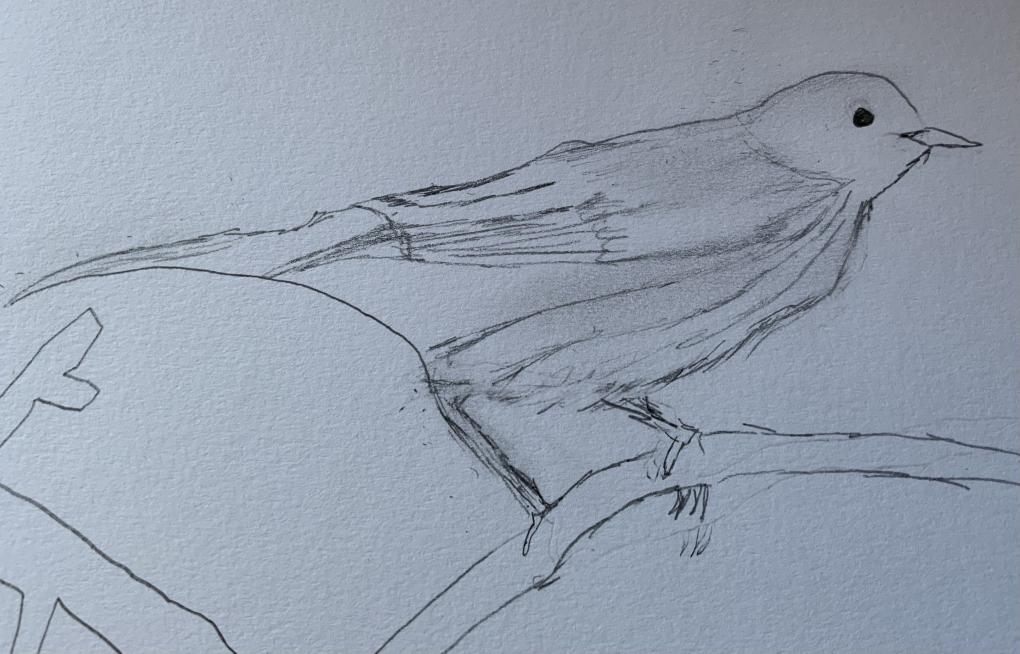
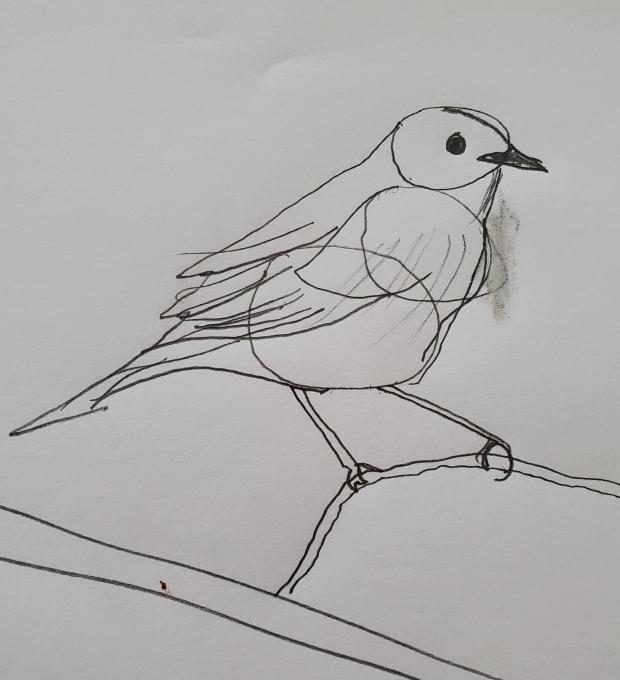 It was hard to be confident that I could do this! Realize I need a good eraser,,, thought about shapes I saw like the other person said they did. Was happy with this try
It was hard to be confident that I could do this! Realize I need a good eraser,,, thought about shapes I saw like the other person said they did. Was happy with this try 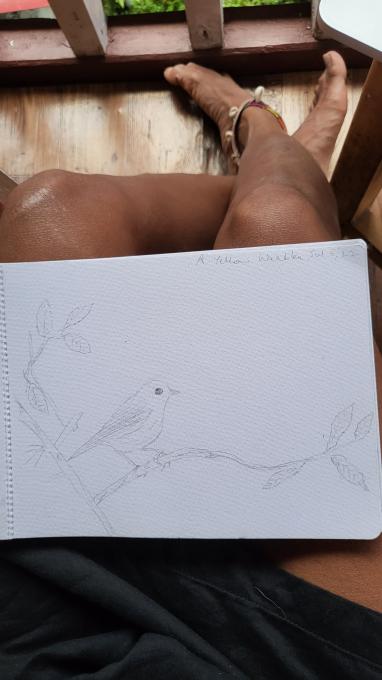
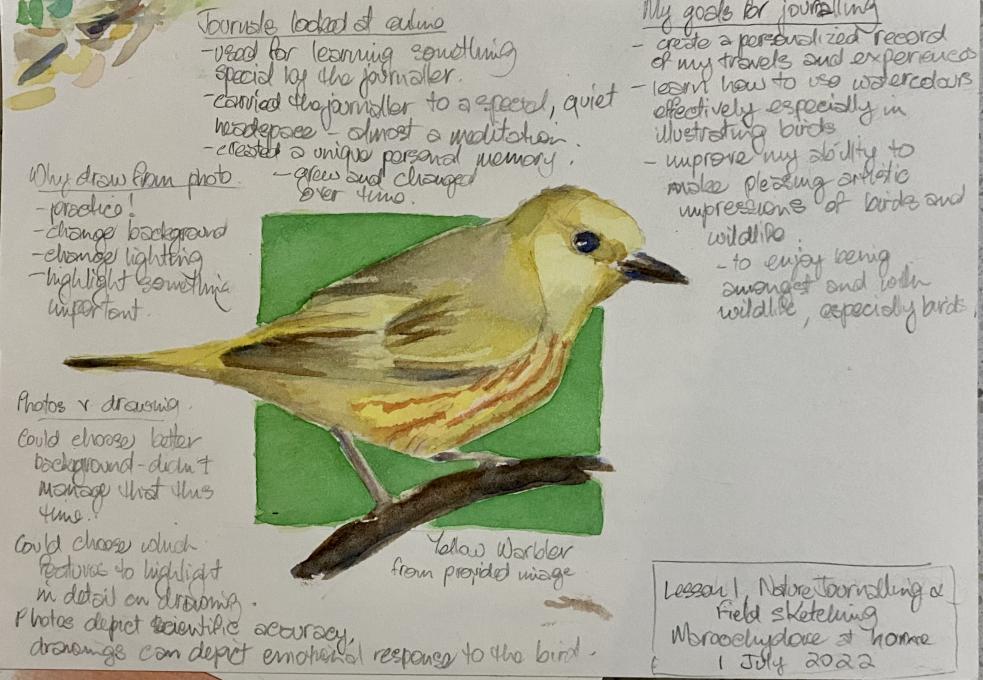
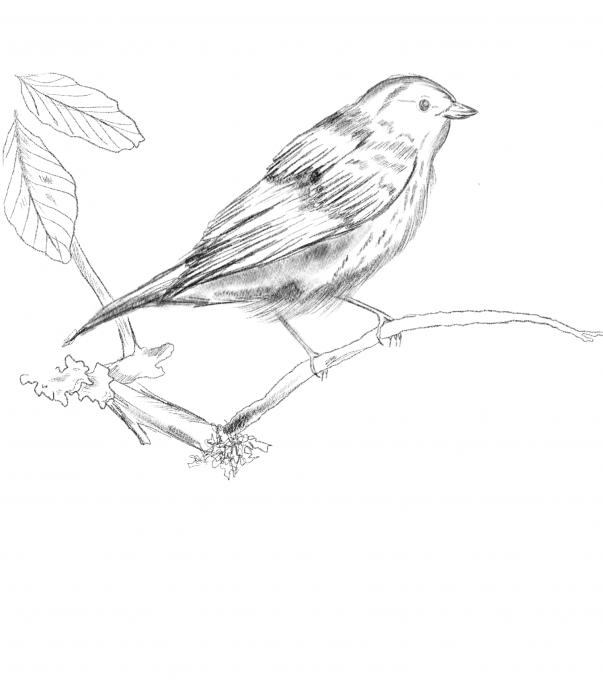
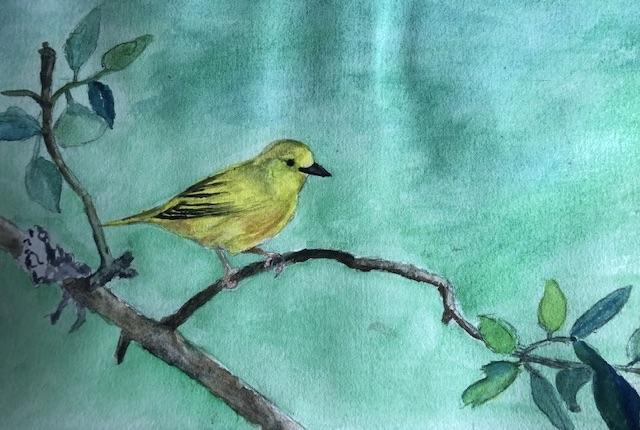
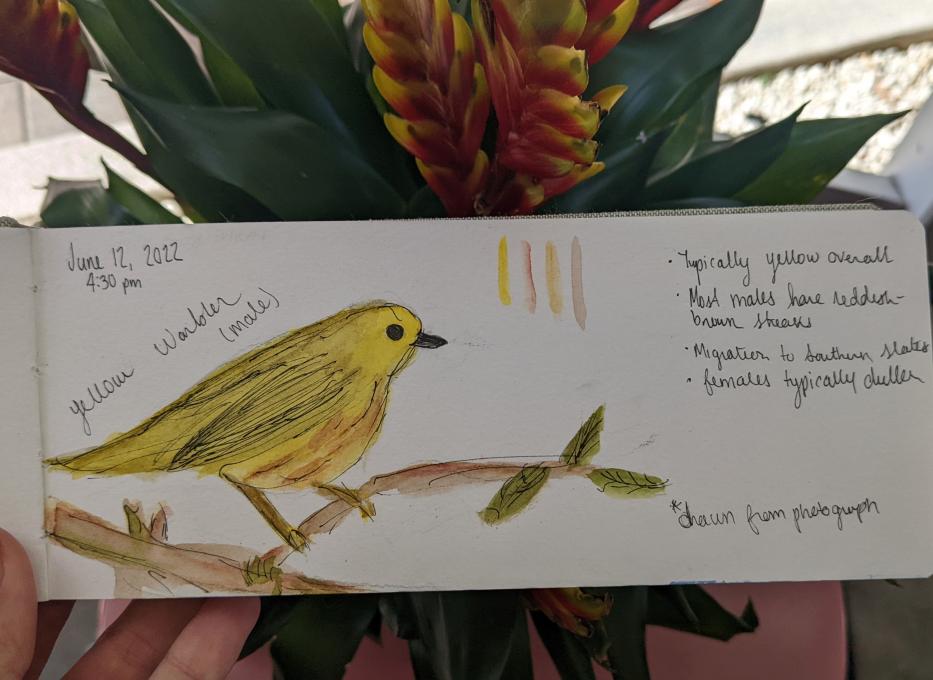
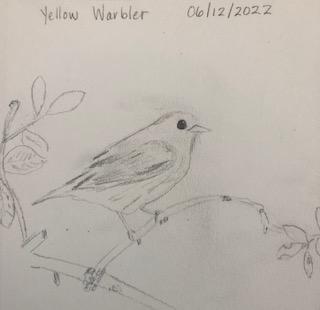 I did okay for my first attempt. The eye is a bit too big. I could see the angles and the shapes, but it is more challenging to replicate. The shading and the coloring is challenging in just a pencil drawing. I noticed how the moss is similar in color to the warbler. Drawings can capture the minute details. Photographs can show clearly the intense colors.
I did okay for my first attempt. The eye is a bit too big. I could see the angles and the shapes, but it is more challenging to replicate. The shading and the coloring is challenging in just a pencil drawing. I noticed how the moss is similar in color to the warbler. Drawings can capture the minute details. Photographs can show clearly the intense colors. 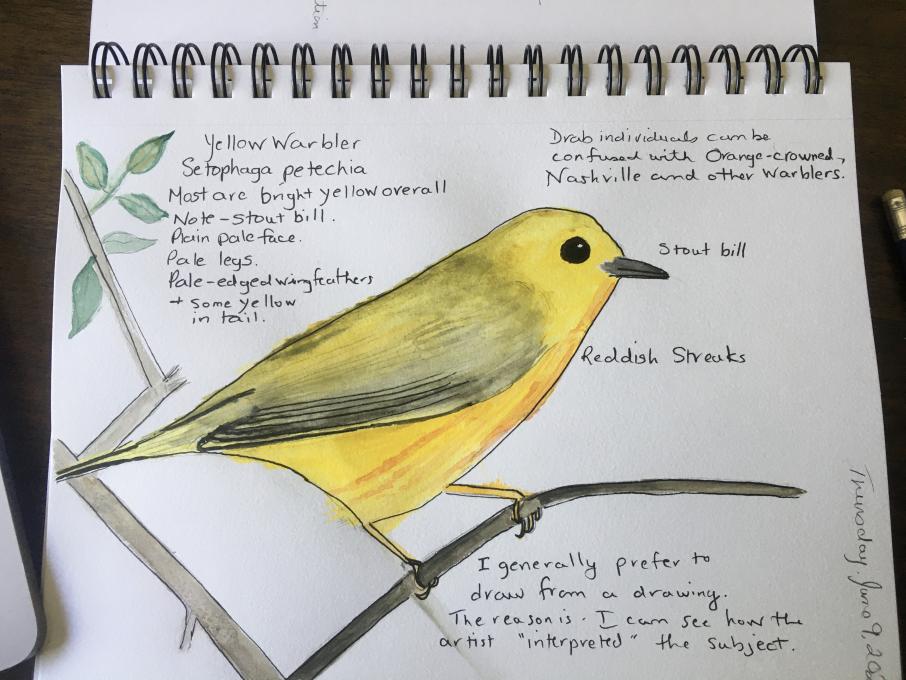
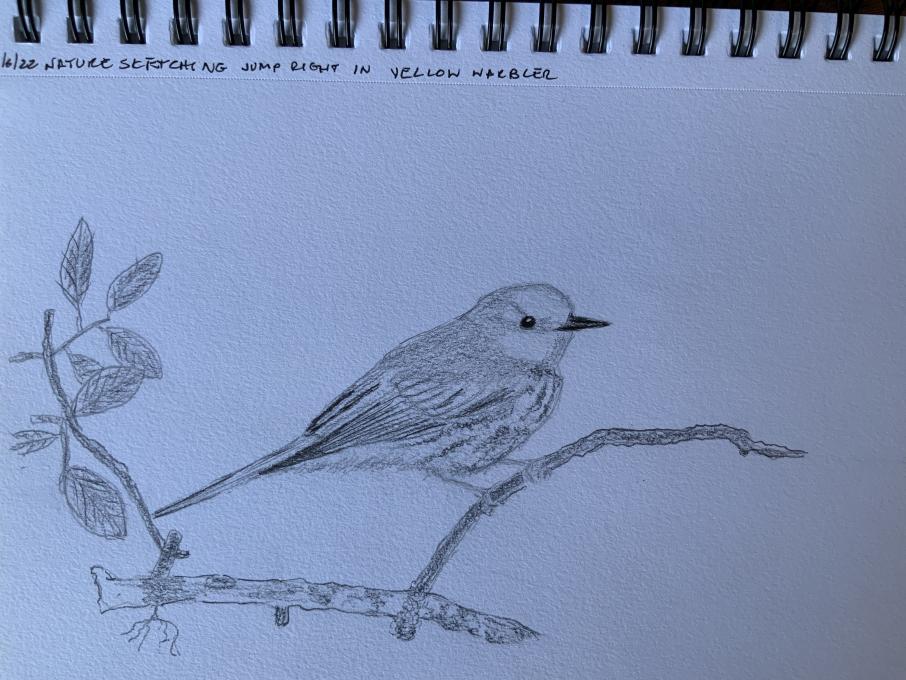
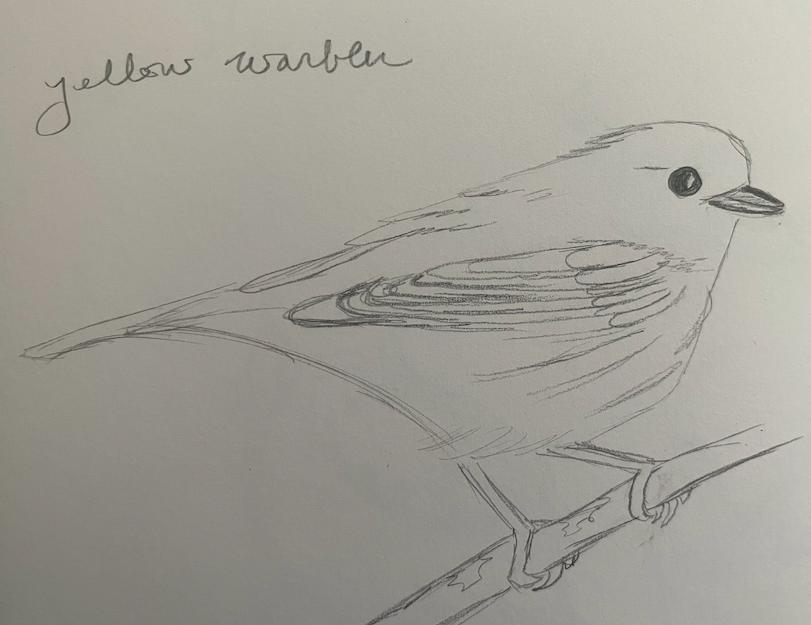 I like the stability and clarity of the photo, though I'd rather be outside with this little guy. I noticed colors and feather shapes I would not have without drawing it. I'm definitely here to draw and not take photos-- though I'll keep doing that, too!
I like the stability and clarity of the photo, though I'd rather be outside with this little guy. I noticed colors and feather shapes I would not have without drawing it. I'm definitely here to draw and not take photos-- though I'll keep doing that, too! 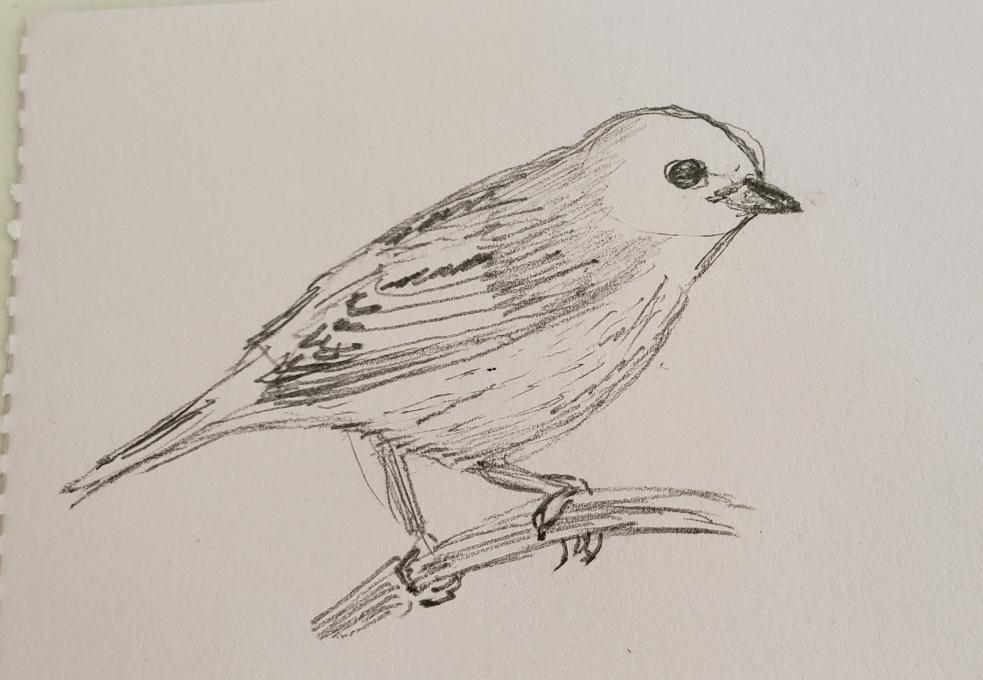 I noticed things that I never had about Yellow Warblers, particularly how much black is in the wing. I tried not to do a lot of erasing, but I obviously need to!
I noticed things that I never had about Yellow Warblers, particularly how much black is in the wing. I tried not to do a lot of erasing, but I obviously need to! 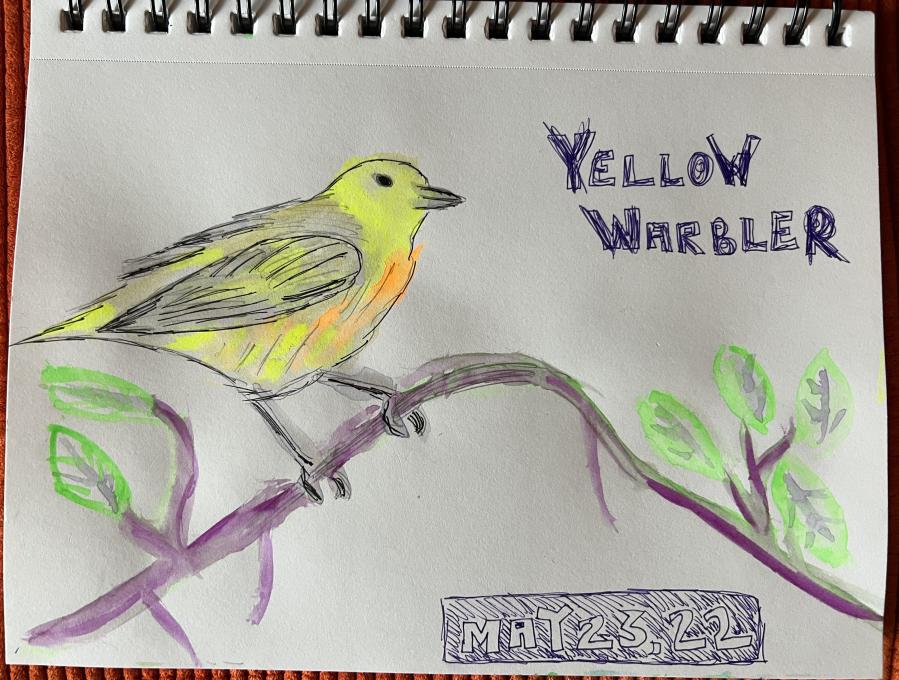
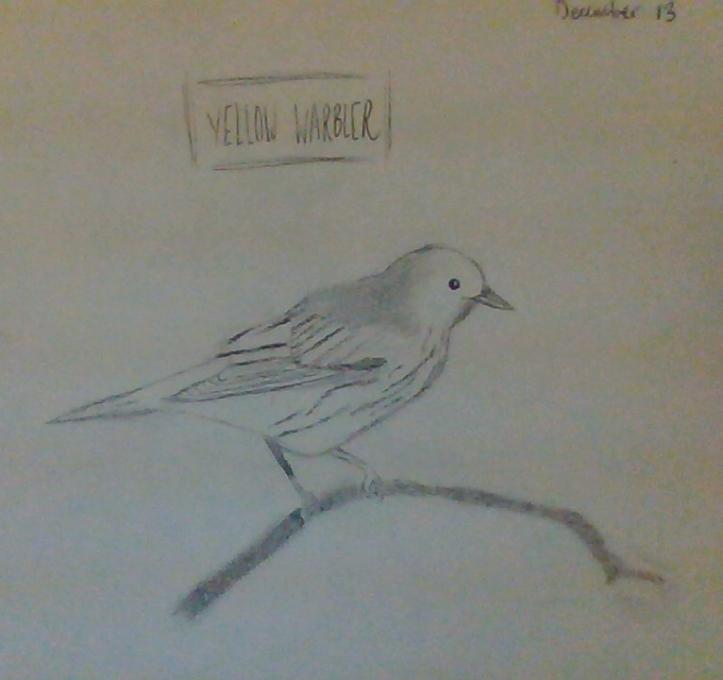
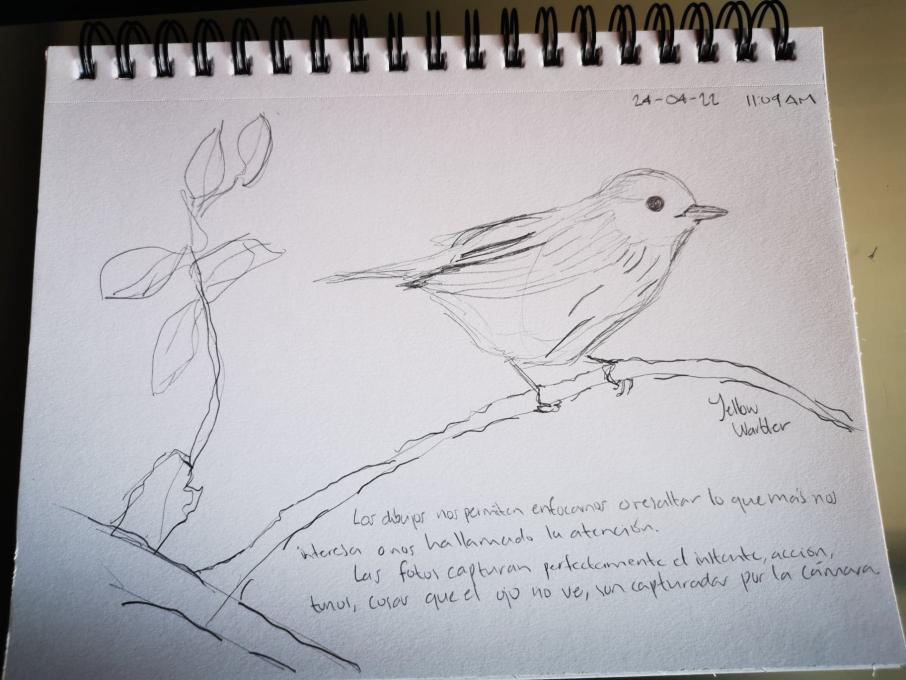
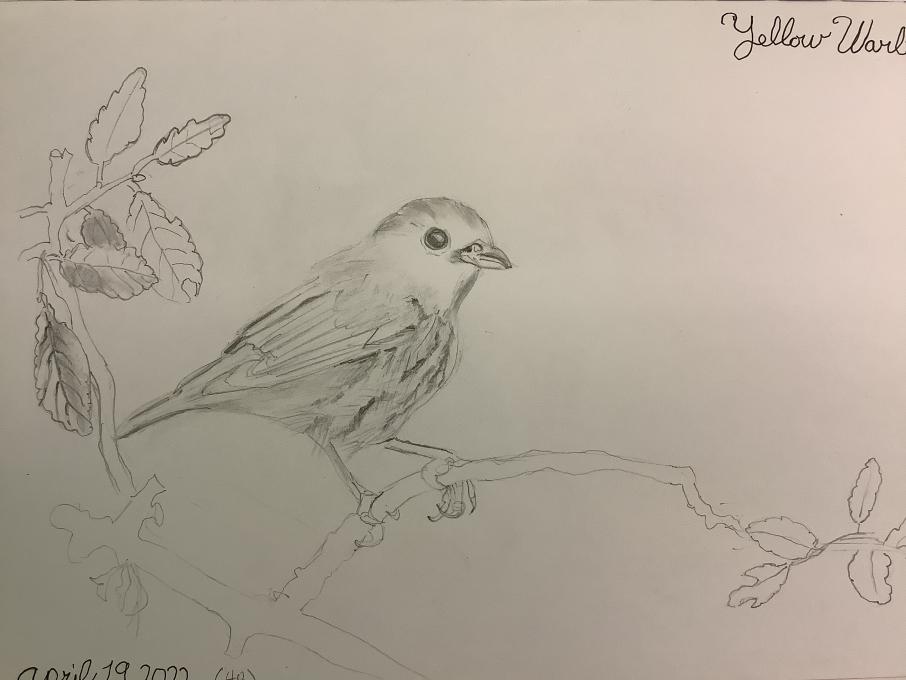
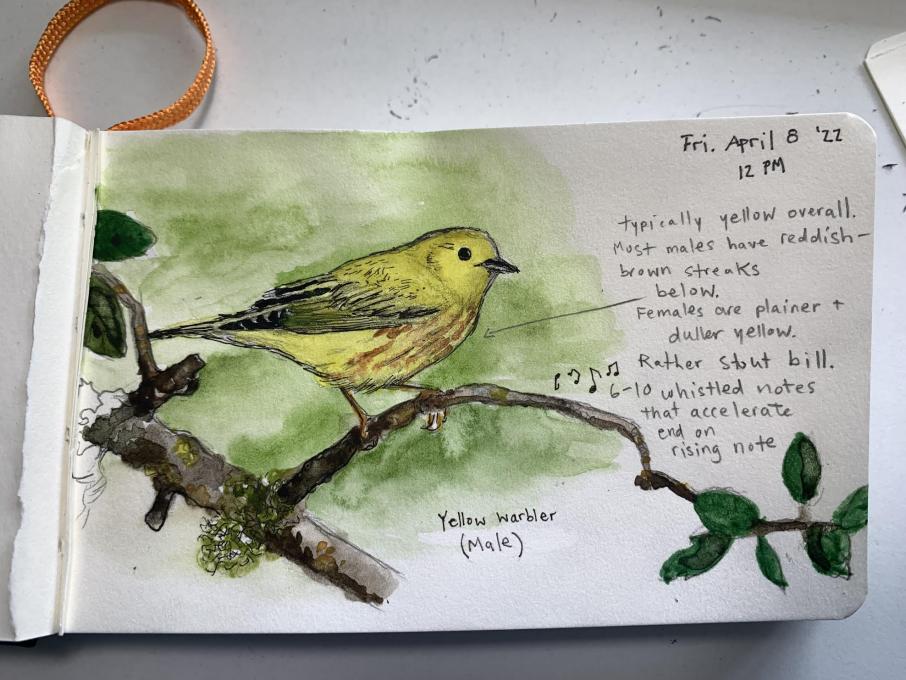 Drawing from the photo felt easier than trying to sketch a bird in the field. There is the luxury of everything sitting still. Using colour - in this case watercolour - is new to me, so I find it challenging and I hope to improve this. I want to learn how to use the colours for reference without losing details that my pencil and pen create. I might have overlooked the feather groupings and the colour of the legs as well as the shape of the leaves if I had not stopped to draw it.
-Laurna, Toronto Canada
Drawing from the photo felt easier than trying to sketch a bird in the field. There is the luxury of everything sitting still. Using colour - in this case watercolour - is new to me, so I find it challenging and I hope to improve this. I want to learn how to use the colours for reference without losing details that my pencil and pen create. I might have overlooked the feather groupings and the colour of the legs as well as the shape of the leaves if I had not stopped to draw it.
-Laurna, Toronto Canada 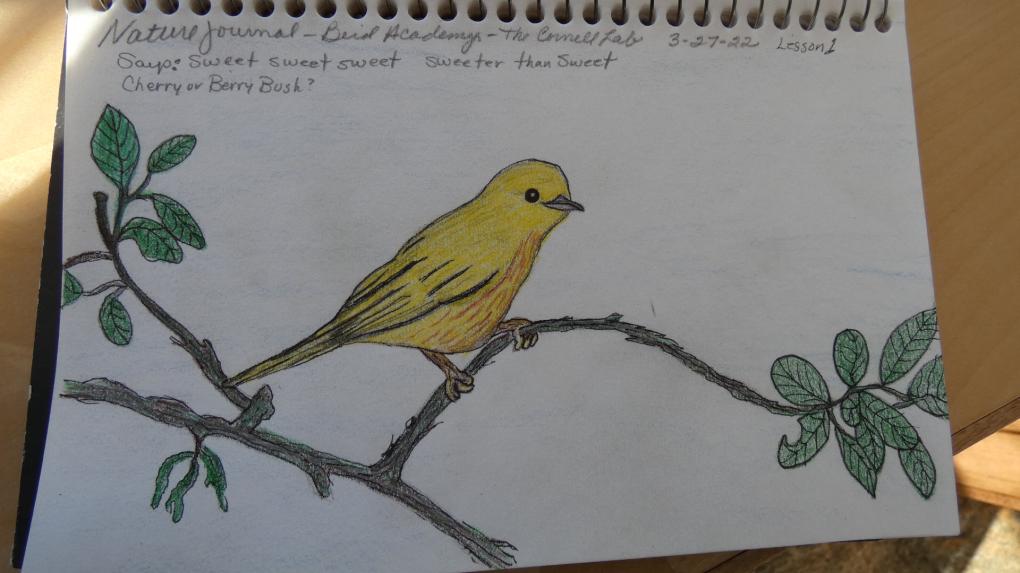
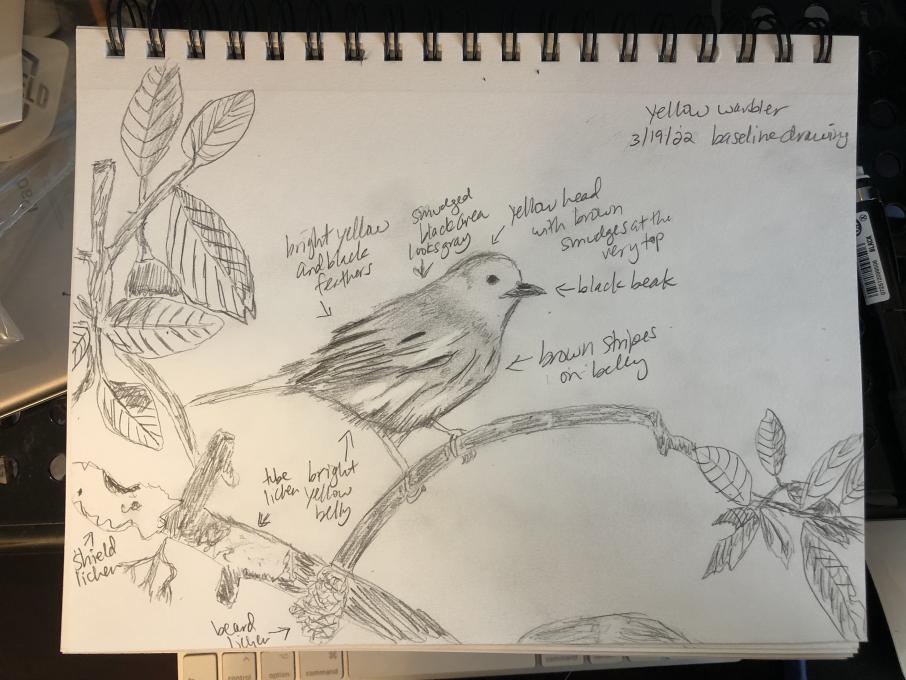
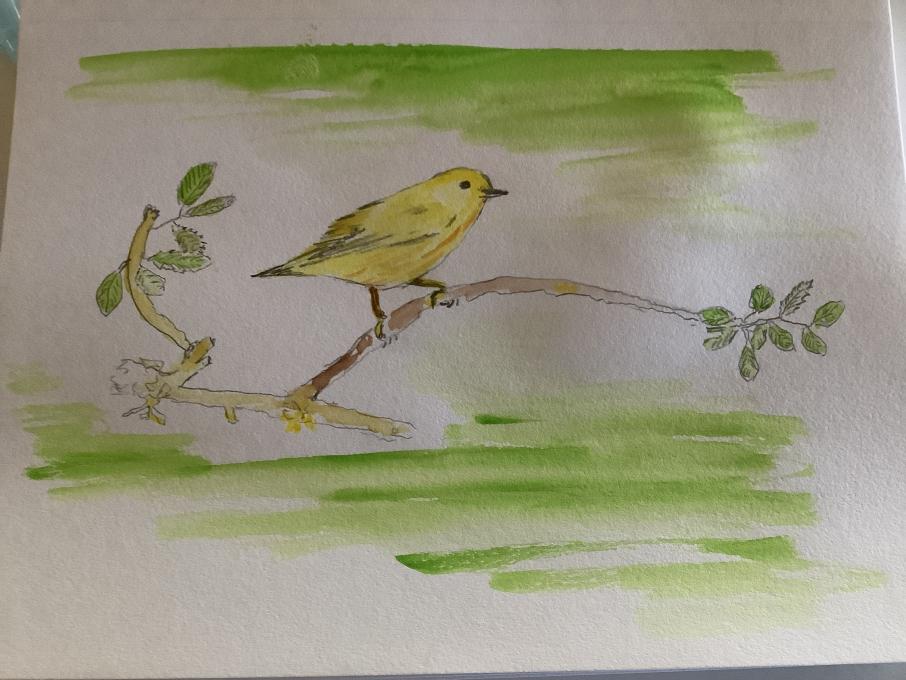 Drawing really made me look at the details. It imprinted them in a way that the photograph did not. The drawing tests my patience. The photo is instant gratification.
Drawing really made me look at the details. It imprinted them in a way that the photograph did not. The drawing tests my patience. The photo is instant gratification.